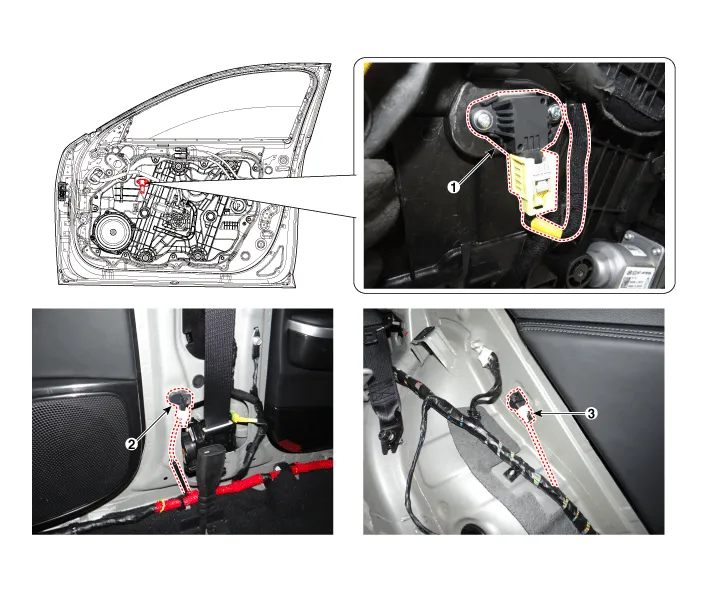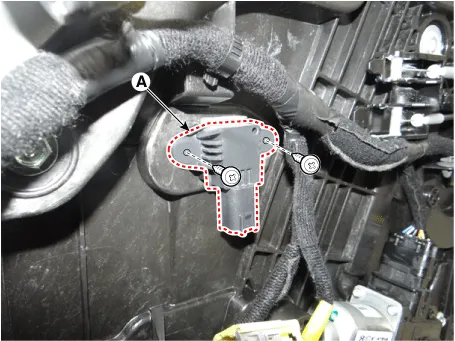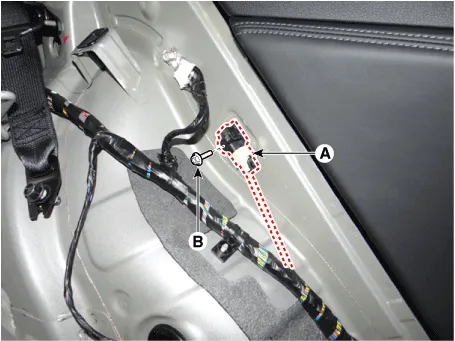Kia Stinger CK: SRSCM / Side Impact Sensor (SIS)
Description and operation
| Description |
| • |
Side Impact Sensor (SIS) system consists of two Pressure Side Impact Sensor (P-SIS) installed at each center of the front door module (LH and RH), two SIS installed at each center pillar nearby (LH and RH) and two rear SIS installed in the rear pillar (LH and RH). |
| • |
Pressure Side Impact Sensor is also called P-SIS because it detects pressure from collision at its mounting location. |
| • |
Side Impact Sensor is also called A-SIS because it detects acceleration. |
| • |
SRSCM decides deployment of the airbag and the time of deployment through the collision signal of the SIS when the collision occurred. |
Components and components location
| Components |

| 1. Front Pressure Side Impact
Sensor (P-SIS) 2. Front Gravity Side Impact Sensor (G-SIS) |
3. Rear side Impact Sensor (R-SIS)
|
Repair procedures
| Removal |
Front Pressure Side Impact Sensor (P-SIS)
| 1. |
Disconnect the negative battery terminal, and wait for at least thirty seconds before beginning to work. |
| 2. |
Remove the front door trim. (Refer to Body (Interior and Exterior) - "Front Door Trim") |
| 3. |
Remove the pressure side impact sensor (A).
|
| 4. |
Loosen the side pressure sensor mounting screw, and remove the sensor (A).
|
Front Gravity Side Impact Sensor (G-SIS)
| 1. |
Disconnect the negative battery terminal, and wait for at least thirty seconds before beginning to work. |
| 2. |
Remove the door scuff trim. (Refer to Body (Interior and Exterior) - "Door Scuff Trim") |
| 3. |
Remove the center pillar trim. (Refer to Body (Interior and Exterior) - "Center Pillar Trim") |
| 4. |
After disconnecting the side impact sensor connector (A) and loosening the bolt (B), remove the sensor.
|
Rear Side Impact Sensor (R-SIS)
| 1. |
Disconnect the negative battery terminal, and wait for at least thirty seconds before beginning to work. |
| 2. |
Remove the rear seat assembly. (Refer to Body (Interior and Exterior) - "Rear Seat Assembly") |
| 3. |
Remove the rear side impact sensor connect (A). |
| 4. |
Loosen the rear side impact sensor nut (B), and remove the sensor.
|
| Installation |
Front Pressure Side Impact Sensor (P-SIS)
| 1. |
Disconnect the negative battery terminal, and wait for at least thirty seconds before beginning to work. |
| 2. |
Install in the reverse order of removal. |
| 3. |
After installing the pressure side impact sensor, confirm proper system operation: • Switch "ON" the ignition. The SRS indicator light should turn on for about six seconds and then off.
|
Front Gravity Side Impact Sensor (G-SIS)
| 1. |
Disconnect the negative battery terminal, and wait for at least thirty seconds before beginning to work. |
| 2. |
Install in the reverse order of removal. |
| 3. |
After installing the side impact sensor, confirm proper system operation: • Switch "ON" the ignition. The SRS indicator light should turn on for about six seconds and then off. |
Rear Side Impact Sensor (R-SIS)
| 1. |
Disconnect the negative battery terminal, and wait for at least thirty seconds before beginning to work. |
| 2. |
Install in the reverse order of removal. |
| 3. |
After installing the side impact sensor, confirm proper system operation: • Switch "ON" the ignition. The SRS indicator light should turn on for about six seconds and then off. |
Other information:
Kia Stinger (CK) 2018-2023 Service Manual: Recommended cold tire inflation pressures
All tire pressures (including the spare) should be checked when the tires are cold. “Cold Tires” means the vehicle has not been driven for at least three hours or driven less than 1.6 km (one mile). Recommended pressures must be maintained for the best ride, top vehicle handling, and minimum tire wear. For recommended inflation pressure refer to “Tire and wheels” in chapter 8.Kia Stinger (CK) 2018-2023 Service Manual: Timing Chain Cover
Repair procedures Removal In case of removing the high pressure fuel pump, high pressure fuel pipe, delivery pipe, and injector, there may be injury caused by leakage of the high pressure fuel. So don’t do any repair work right after engine stops. • Use fender covers to avoid damaging painted surfaces.






